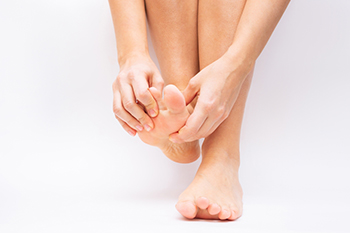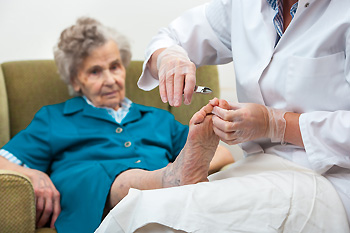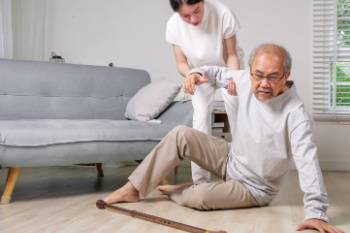3885 S. Decatur Blvd Suite #1080
Las Vegas, NV 89103

Tingling toes may be little more than the result of wearing tight shoes and socks or standing for long periods. But persistent or painful tingling in the toes should not be ignored, as it can signal serious underlying health issues. Among the major concerns is diabetes. High blood sugar levels damage blood vessels and nerves, which can lead to tingling, numbness, and pain in the toes if left untreated. Similarly, autoimmune disorders, such as multiple sclerosis, can disrupt nerve communication, causing tingling sensations, weakness, and numbness, particularly during exercise or rest. Raynaud’s disease, a condition triggered by extreme sensitivity to cold or stress, can lead to tingling or stinging pain in the extremities when exposed to cold temperatures. Deficiencies in essential B vitamins also can contribute to nerve damage and result in tingling, weakness, and numbness in the toes. Various other health issues can cause tingling toes, including stroke, shingles, atherosclerosis. Seizures, underactive thyroid, and certain side effects from medication are other causes. For these reasons, it is suggested that if you have been experiencing persistent tingling in the toes, please schedule an appointment with a podiatrist for a thorough exam.
Toe pain can disrupt your daily activities. If you have any concerns, contact Loren Hansen, DPM of Ankle & Foot Medical Center. Our doctor can provide the care you need to keep you pain-free and on your feet.
What Causes Toe Pain?
Most severe toe pain is caused due to a sports injury, trauma from dropping something heavy on the toe, or bumping into something rigid. Other problems can develop over time for various reasons.
Toe pain can be caused by one or more ailments. The most common include:
When to See a Podiatrist
Diagnosis
In many cases the cause of toe pain is obvious, but in others, a podiatrist may want to use more advanced methods to determine the problem. These can range from simple visual inspections and sensation tests to X-rays and MRI scans. Prior medical history, family medical history, and any recent physical traumatic events will all be taken into consideration for a proper diagnosis.
Treatment
Treatments for toe pain and injuries vary and may include shoe inserts, padding, taping, medicines, injections, and in some cases, surgery. If you believe that you have broken a toe, please see a podiatrist as soon as possible.
If you have any questions please feel free to contact our office located in Las Vegas, NV . We offer the newest diagnostic tools and technology to treat your foot and ankle needs.

As we age, our feet undergo various changes, often leading to discomfort and mobility issues. Treatment for common foot ailments among seniors varies, depending on the condition. Bunions may require shoe modifications, custom orthotics, medication, or surgery from a podiatrist. Hammertoe deformities may necessitate changes in footwear or in some cases surgery. Toenail problems, including ingrown nails and infections, require professional attention to prevent complications, with podiatrists offering specialized care and treatment options. Seniors with diabetes must prioritize foot health and regular podiatric evaluations to prevent serious complications, such as foot ulcers or gangrene. Plantar fasciitis treatment ranges from conservative measures, such as exercises, to surgery for effective relief. Arch problems, whether flat feet or high arches, generally necessitate a non-surgical approach along with expert guidance to manage discomfort and prevent further complications. For help with any of the many foot conditions common among seniors, it is suggested that you schedule an appointment with a podiatrist for a thorough foot exam, diagnosis, and treatment options.
Proper foot care is something many older adults forget to consider. If you have any concerns about your feet and ankles, contact Loren Hansen, DPM from Ankle & Foot Medical Center. Our doctor can provide the care you need to keep you pain-free and on your feet.
The Elderly and Their Feet
As we age we start to notice many changes in our body, but the elder population may not notice them right away. Medical conditions may prevent the elderly to take notice of their foot health right away. Poor vision is a lead contributor to not taking action for the elderly.
Common Conditions
Susceptible Infections
Diabetes and poor circulation can cause general loss of sensitivity over the years, turning a simple cut into a serious issue.
If you have any questions please feel free to contact our office located in Las Vegas, NV . We offer the newest diagnostic and treatment technologies for all your foot and ankle needs.

As you age, the risk of falls becomes a serious concern. Statistics reveal that more than one-fourth of older adults experience a fall each year. Many falls go unreported to doctors despite the doubled chances of falling again after the first incident. Falls often result in severe consequences, such as broken bones or head injuries that may compromise physical health and reduce independence. Contributing factors to falling include foot pain or wearing poorly fitting footwear. Additionally, lower body weakness, vision problems, and medication side effects can contribute to the risk of falls in older adults. To help prevent falls, seniors are encouraged to schedule appointments with a podiatrist to assess foot health, footwear, and gait abnormalities. Engaging in regular strength and balance exercises can help by improving stability and reducing fall risk. Regular eye exams and updating eyeglasses as needed can enhance visual clarity, especially for outdoor activities. Making the home environment safer by eliminating trip hazards, installing grab bars in bathrooms, and ensuring adequate lighting is also important in fall prevention. If you have injured your feet during a fall, it is suggested that you schedule an appointment with a podiatrist.
Preventing falls among the elderly is very important. If you are older and have fallen or fear that you are prone to falling, consult with Loren Hansen, DPM from Ankle & Foot Medical Center. Our doctor will assess your condition and provide you with quality advice and care.
Every 11 seconds, an elderly American is being treated in an emergency room for a fall related injury. Falls are the leading cause of head and hip injuries for those 65 and older. Due to decreases in strength, balance, senses, and lack of awareness, elderly persons are very susceptible to falling. Thankfully, there are a number of things older persons can do to prevent falls.
How to Prevent Falls
Some effective methods that older persons can do to prevent falls include:
Falling can be a traumatic and embarrassing experience for elderly persons; this can make them less willing to leave the house, and less willing to talk to someone about their fears of falling. Doing such things, however, will increase the likelihood of tripping or losing one’s balance. Knowing the causes of falling and how to prevent them is the best way to mitigate the risk of serious injury.
If you have any questions, please feel free to contact our office located in Las Vegas, NV . We offer the newest diagnostic and treatment technologies for all your foot care needs.